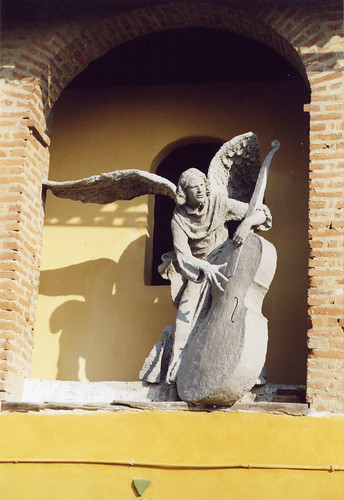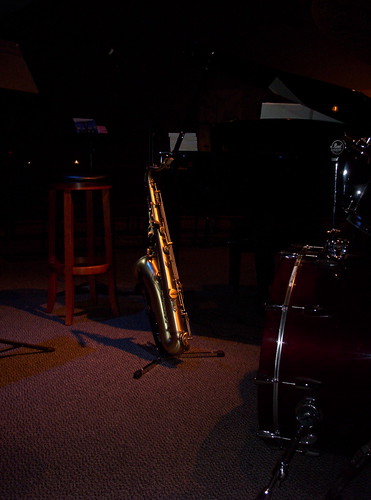I posted earlier that I would be posting an update related to the modifications I’ve made to my bass recently. After a couple weeks with the changes and some others’ opinions, I feel that I can make a substantive post about the effects of these changes.

My bass orignally came like this. It has a taipiece riser and adjustable bridge. The tailpiece is a beautiful hand-carved image of a woman playing a violin-like instrument. Rumano doubled the lower-bout ribs as a measure of stability. One of my first comments on receiving the bass was how heavy it was. In addition to being one of the largest basses I have personally played, it is also one of the heaviest.
This was compounded by repairs done this summer. Rumano doubled the upper-bout ribs, increasing the wieght!

This is what it looked like just before the modifications. The primary differences are the (rather heavy) KC Strings Extension with chromatic stops and the carbon-fiber Laborie Endpin.

I installed the extneion myself and was marginally pleased with the results. I had poorly fit the extension to the scroll; I had cut it too long so the deepest point of the brass was beyond the extension and it sat too high, causing very high action with the extension open.
My jazz instructor, Mark Neuenschwander had been opening my eyes to
just how dark my bass sounded. It was great for arco; my classical
teacher, Dee Moses was very happy with the sound. I needed to find a
compromise and Mark suggest that removal of mass would be a great place to start.
After all the recent work, this is what my bass now looks like:


1|Extension:
I removed three of the stops to reduce weight. This is slightly inconvienient, as I am no longer able to close these gates for an open D, Db, or Eb. The reduction in weight makes this worth it, in my opinion.
I also cut down the nut-end of the extension to center it over the scroll and used a Dremel sanding drum to remove virtually all the wood. I inserted foam to bring the height up, but have not yet got it high enough to remove all buzzing. I expect another layer or two of foam will produce the results I’m looking for, buzz-free low action.
2|Strings
I put on a new set of Obligatos. I’ve used Obs almost exclusively, but some friendly harrassment from teacher Mike Hill led me to try Picatos by Innovation. I forget if they were the braided or solid core, but they were awful. THe sound was respectable, but the QC issues with mine were un-ignorable. There were gaps in the winding upon installation as well as what appeared to be grafts in the outer winding, resulting in spots that were thicker than others.
While changing strings, I performed the most substantial modification to the bass:
3|The Marvin Tailpiece
Kevin Marvin of MD had posted on the 2xbasslist about his wire tailpiece in the past. I decided to give it a try in order to get rid of more of that pesky mass. I won’t speak for the intention of its design, only my experience with it.
The design is very untraditional. It does not look like a normal taipiece. It is made of two very thin wires that wrap around the endpin collar, are braided over the saddle, and then diverge into four ends, terminating in a loop through a slice of what appears to be brass pipe. The brass has a hole opposite the wire, through which the strings are strung.
Mark and I both received Marvin tailpieces in the same package. When Mark brought mine to my lesson, I was not sure it was for my (very, very large) bass. Mark assured me that it was, indeed, the longer of the two and I set out to install it.
Installation was a breeze. My one concern is that the staggered loops mean that there is less of my C string on the tuning post than I am used to, but there is more than enough to lock the string in place. Pickups, mustes, and quivers are not very convenient with the tailpiece. I’ll cover that shortly.
The soundpost fell during the string/tailpiece change and I had to re-set it. I do not believe it migrated much at all, as I had clearly marked its location prior to the work, but this is definitely a factor in the sound of my bass.
Playing the bass for the first time yeilded something I had never experienced with this bass: a metallic tone. Even with metal-core strings, I had never experienced a metallic/twangy sound, but here I was experiencing them with Obligatos!
I am convinced that there is a change in the construction of the Obligatos as this set does not “roll,” as Obligatos are famous for doing. This may cause some of the change in tone, I will be asking Chris at Quinn Violins this week if there has been a change.
After a couple hours of playing, the string mellowed considerably and are now just extremely powerful. My bass is louder and brighter than I have ever heard it. In my case, “brighter” is a welcome change in tone. I cannot be sure what this tailpiece would do for another bass, but it made all positive changes to the feel, playability, and tone of my instrument.
I have removed the quiver from my bass, which may be less convenient, but (more than likely) is a positive change for the tone. My Revolution Solo jack was jimmy-rigged tot he C string with a rubberband, an inelegant, but functional solution. I have not had to use a mute yet, but imagine I will be looking for a non-tourte mute shortly.
This is the most recent photo of my bass:

 This has been my life of late. Yesterday, I broke down and went to Watson Clinic after two-and-a-half days of severe fever, headache, muscle ache, congestion, etc. In triage, the nurse got readings of a 104+ degree Farenheit temp and a (get this!) 230+ bpm pulse!
This has been my life of late. Yesterday, I broke down and went to Watson Clinic after two-and-a-half days of severe fever, headache, muscle ache, congestion, etc. In triage, the nurse got readings of a 104+ degree Farenheit temp and a (get this!) 230+ bpm pulse!








